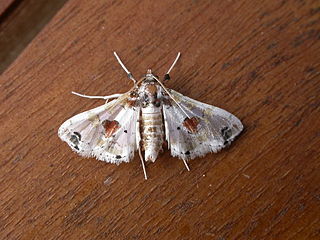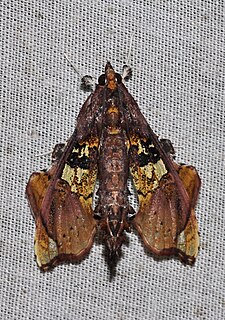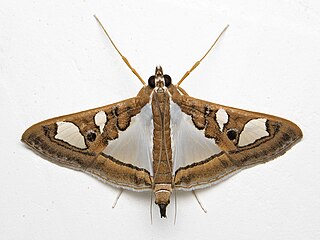
Spilomelinae is a very species-rich subfamily of the lepidopteran family Crambidae, the crambid snout moths. With 4,132 described species in 340 genera worldwide, it is the most speciose group among pyraloids.
Asciodes is a genus of snout moths in the subfamily Spilomelinae of the family Crambidae. The genus was erected by Achille Guenée in 1854 with Asciodes gordialis as type species.
Asturodes is a genus of snout moths in the subfamily Spilomelinae of the family Crambidae. The genus is placed in the tribe Margaroniini.

Conchylodes is a genus of snout moths in the family Crambidae. The genus comprises 21 species and is placed in the tribe Udeini.
Hydropionea is a genus of moths of the family Crambidae. The 13 described species are distributed in Central and South America.

Leucinodes is a genus of moths of the family Crambidae. It was first described by Achille Guenée in 1854.

Lineodes is a genus of snout moths of the subfamily Spilomelinae in the family Crambidae. The genus was described by Achille Guenée in 1854, with Lineodes hieroglyphalis as the type species.

Udea is a genus of snout moths in the subfamily Spilomelinae of the family Crambidae. The genus was erected by Achille Guenée in 1845. The currently known 214 species are present on all continents except Antarctica. About 41 species are native to Hawaii.

Lygropia is a genus of snout moths in the subfamily Spilomelinae of the family Crambidae. It currently comprises 66 species, which are mostly found in the tropical and subtropical regions of the Americas, Africa and Asia, but not in Australia.
Sisyracera is a genus of snout moths in the subfamily Spilomelinae of the family Crambidae. It was described in 1890 by Heinrich Benno Möschler with Leucinodes preciosalis as type species, now considered a synonym of Sisyracera subulalis. The genus has been placed in the tribe Udeini.

Terastia is a genus of snout moths in the subfamily Spilomelinae of the family Crambidae. It was described by Achille Guenée in 1854 with Terastia meticulosalis as type species. The genus is currently placed in the tribe Margaroniini, where it is closely related to the genera Agathodes and Liopasia.
Glaphyriinae is a subfamily of the lepidopteran family Crambidae. It was described by William Trowbridge Merrifield Forbes in 1923

Lineodini is a tribe of the species-rich subfamily Spilomelinae in the snout moth family Crambidae.
Udeini is a tribe in the species-rich subfamily Spilomelinae in the pyraloid moth family Crambidae. The tribe was erected by Richard Mally, James E. Hayden, Christoph Neinhuis, Bjarte H. Jordal and Matthias Nuss in 2019.

Margaroniini is a tribe of the species-rich subfamily Spilomelinae in the pyraloid moth family Crambidae. The tribe was erected by Charles Swinhoe and Everard Charles Cotes in 1889.

Spilomelini is a tribe of the species-rich subfamily Spilomelinae in the pyraloid moth family Crambidae. The tribe was erected by Achille Guenée in 1854.
Asciodini is a tribe of the species-rich subfamily Spilomelinae in the pyraloid moth family Crambidae. The tribe was erected by Richard Mally, James E. Hayden, Christoph Neinhuis, Bjarte H. Jordal and Matthias Nuss in 2019.
Steniini is a tribe of the species-rich subfamily Spilomelinae in the pyraloid moth family Crambidae. The tribe was erected by Achille Guenée in 1854.
Malickyella iriusalis is a snout moth in the subfamily Spilomelinae of the family Crambidae. It was described by Francis Walker in 1859 in the genus Oligostigma based on material collected on Borneo.
Malickyella tigridalis is a snout moth in the subfamily Spilomelinae of the family Crambidae. It was described by George Hampson in 1897 in the genus Ambia based on specimens collected on Borneo.










